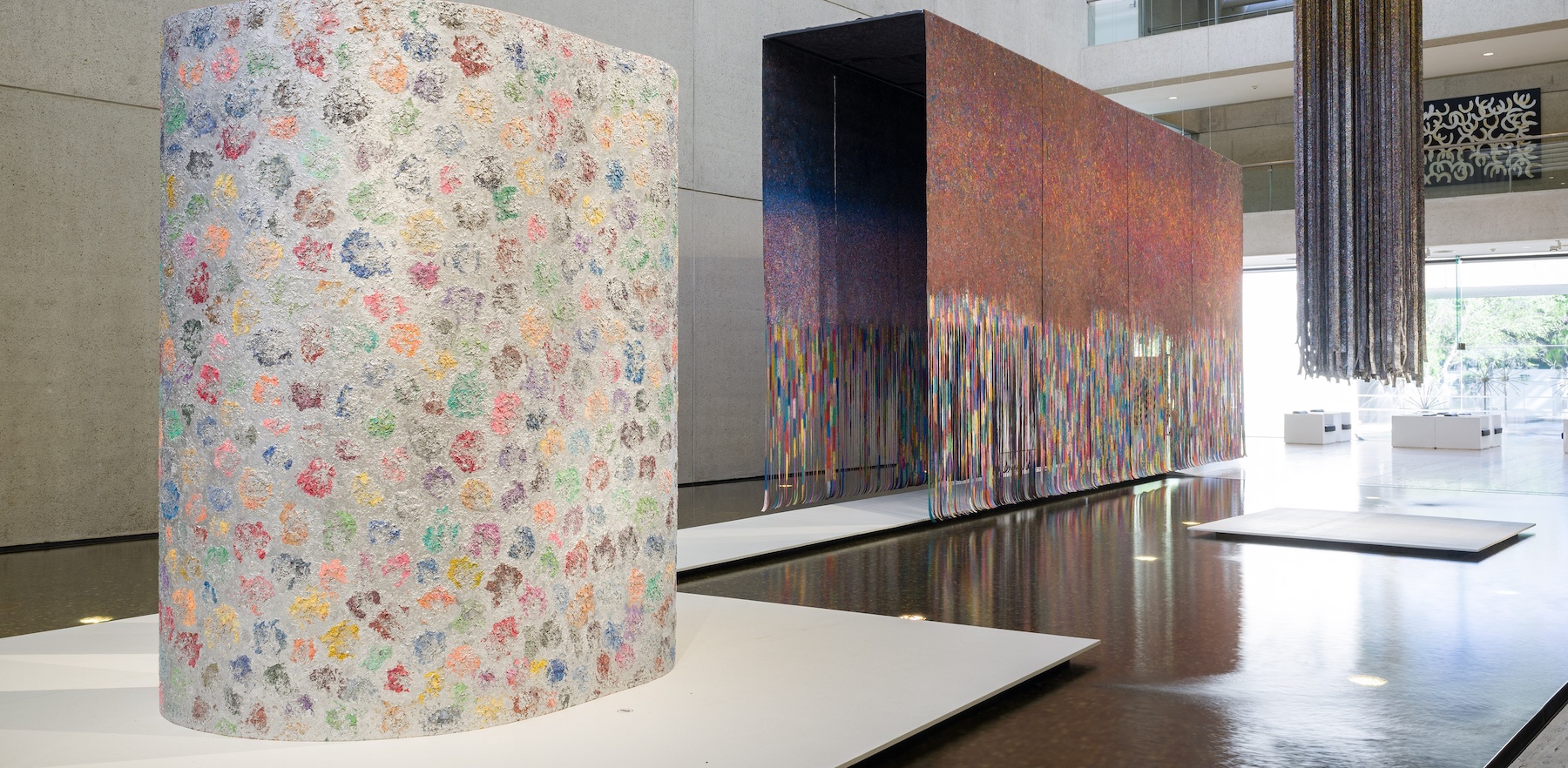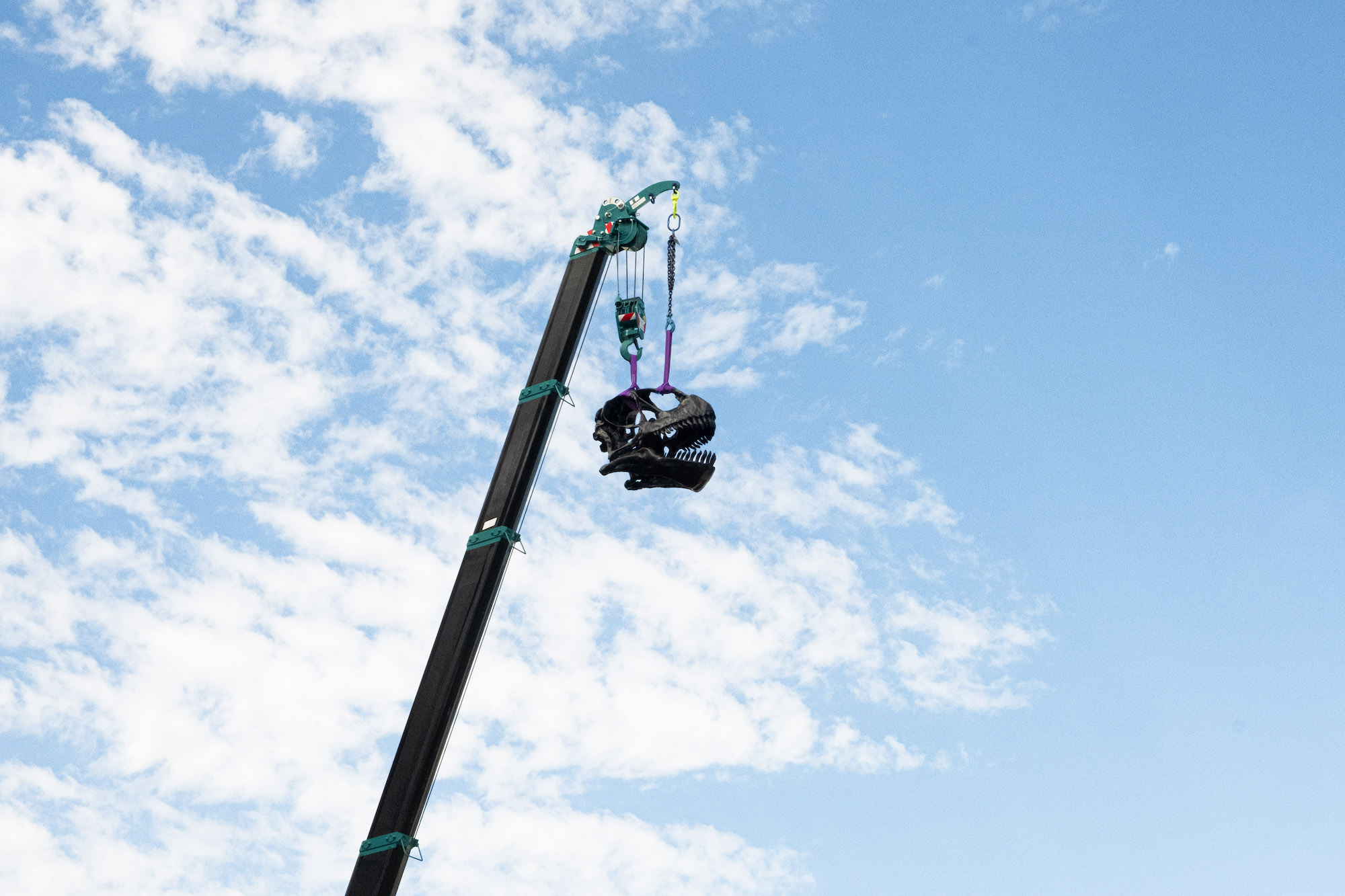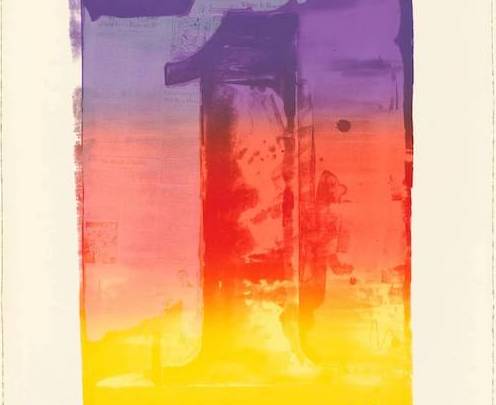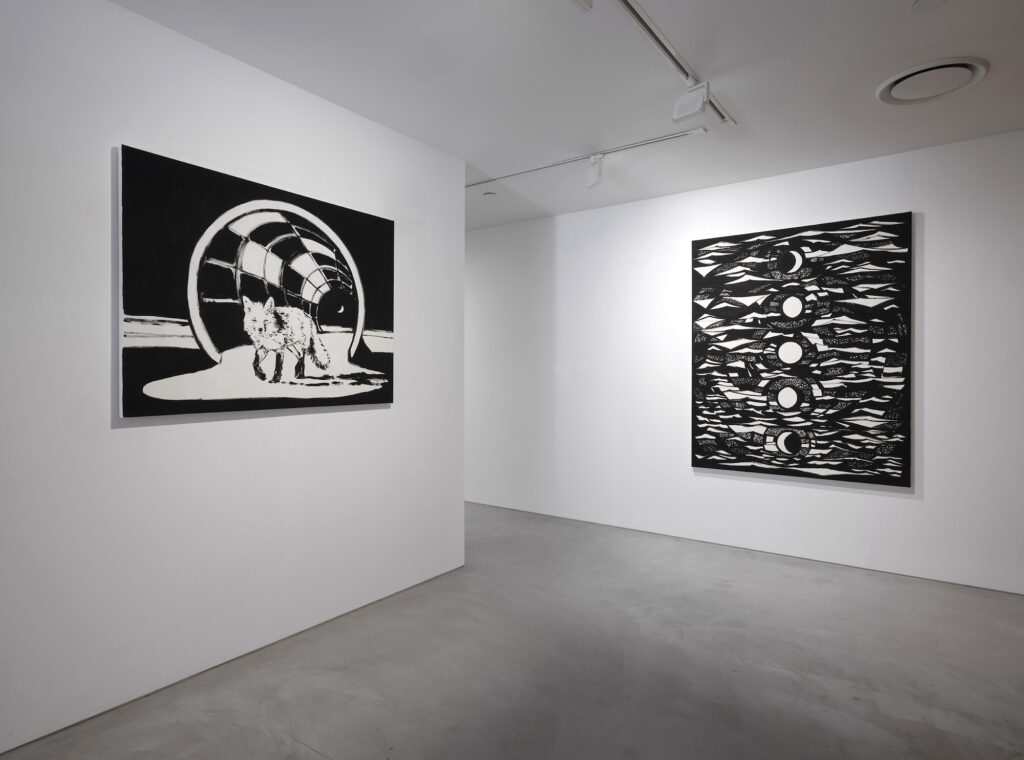
Upon first appearance, Octopus Moon is a turning point for Arryn Snowball, introducing playful pictorial elements consisting of various fauna rarely, if ever, seen in his work. While recent sustained projects like Mammoth and Slack Water have gestured toward the natural world through text, scientific terms, and poetic references to the changing states of the sea and the sky, here we see certain creatures emerging from the abstraction of poetry into the world of representation, a development both fascinating and even shocking for longtime followers of Snowball’s work.
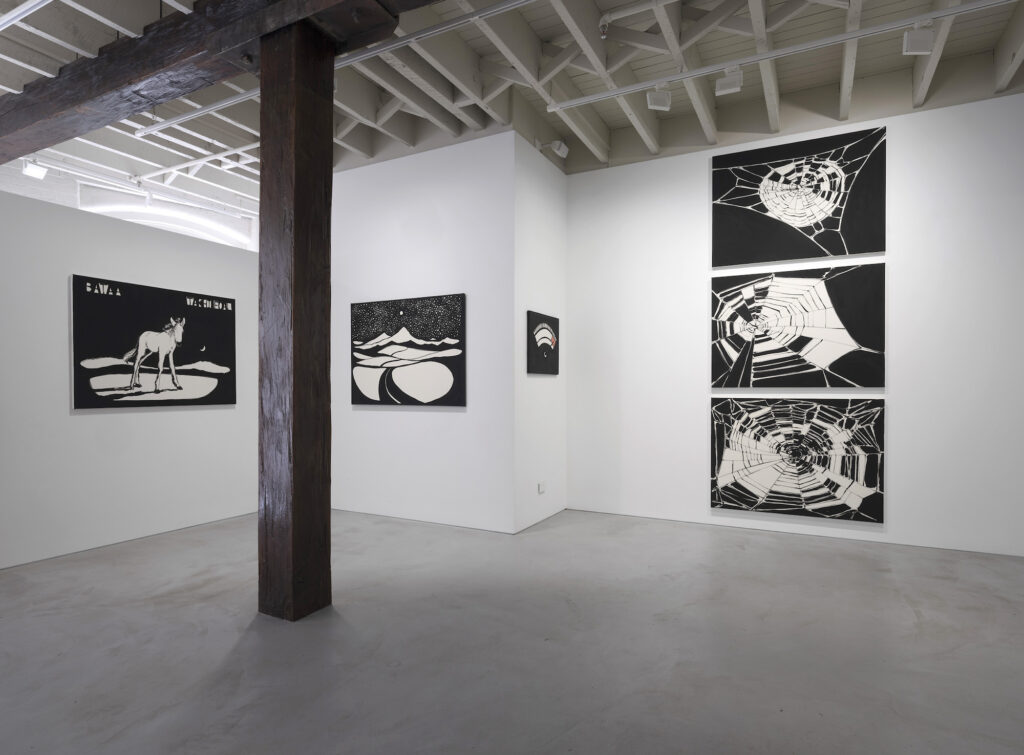
In the past, Snowball’s more representational pieces came with inbuilt qualifiers that kept them tethered to the world of the poetic, the abstract. The artist’s sheet paintings, rendered over a velvety black nothingness, evoking Kazimir Malevich, Ad Reinhardt, and the Minimalist project more broadly; the artist’s steam paintings, capturing the fugitive quality of vaporous water over lush, equally definition-resistant fields; the artist’s many explorations of the simultaneous simplicity and complexity of geometry, are conscious efforts to strip back from intention into something more intangible and even unexplainable. Octopus Moon features several works that seemingly slip this tether (Bataa Takhi Foal (2024), Berlin Fox (2024), Octopus (2024)), bookended by pieces that more emphatically highlight the tensions between abstraction and representation (Octopus & Moons (2024), Strange Sea (2024), Spiderweb 1–3 (2024)). In many ways, the Spiderweb paintings form the most complete distillation of the competing elements of Octopus Moon, maintaining strong visual links to several of the artist’s most notable series, as well as gesturing toward the future.
Landscapes take on a fantastic, graphic quality: Road to the Mountains (2024) and Road to the Moonlit Sea (2024) both evoke the original dust jacket for The Hobbit (1937) (drawn by Tolkien), and there is something of Samuel Palmer about them. These scenes suggest vast horizons and expansive skies, carved out of the canvas with the warm matte finish of iron oxide black tempera. Many of these images are left in the littoral zone where the creation of a work ceases to be the addition of black on white and shift into the covering of the remaining white with black, suggesting a nocturnal space. Palmer’s sense of the Romantic sublime could certainly be traced toward Snowball’s thematic schema in his graphic and crepuscular sensibilities, but I would also argue that Snowball’s approach to the Romantic, if we can call it that, still operates within the aesthetic and phenomenological limits laid out by Colin McCahon. It is notable that while many artists have paid homage to McCahon, these are usually in reference to his monumental text works, rather than the spirit at their core. Snowball’s engagement with McCahon operates in less referential terms and far more as an all-encompassing visual philosophy, which necessitates the stripping back of extraneous parts—whether they be material, aesthetic, or conceptual—leaving as little as possible between the intention and the result.
And this is where, despite the dramatic shift toward a more graphic and perhaps indexical approach to representation, we realise that, actually, these pictures still align with Snowball’s extant oeuvre. Like McCahon, Snowball’s own interest in the world is not limited to a narrow band, but rather a broad continuum. At one end is the more esoteric: philosophy, existentialism, the sublime. Ideas that might help the artist chart some way through the world, ideas that might offer clues to life. At the other end, like McCahon, are scientific texts, the world according to data, based on measurements, observations, and the charting of patterns.
In recent years, Snowball has accompanied his partner, Dr Monica Vasile, a historian of science, on fieldwork to Romania, Mongolia, New Zealand, and Canada, as she interviews scientists working to reintroduce critically endangered species. This has had a profound effect on the artist’s practice in resituating this dialogue between the spectrum of Snowballs’ interests from the more abstract forms and poetic devices allowed in text pieces to something less allusive and more specific.
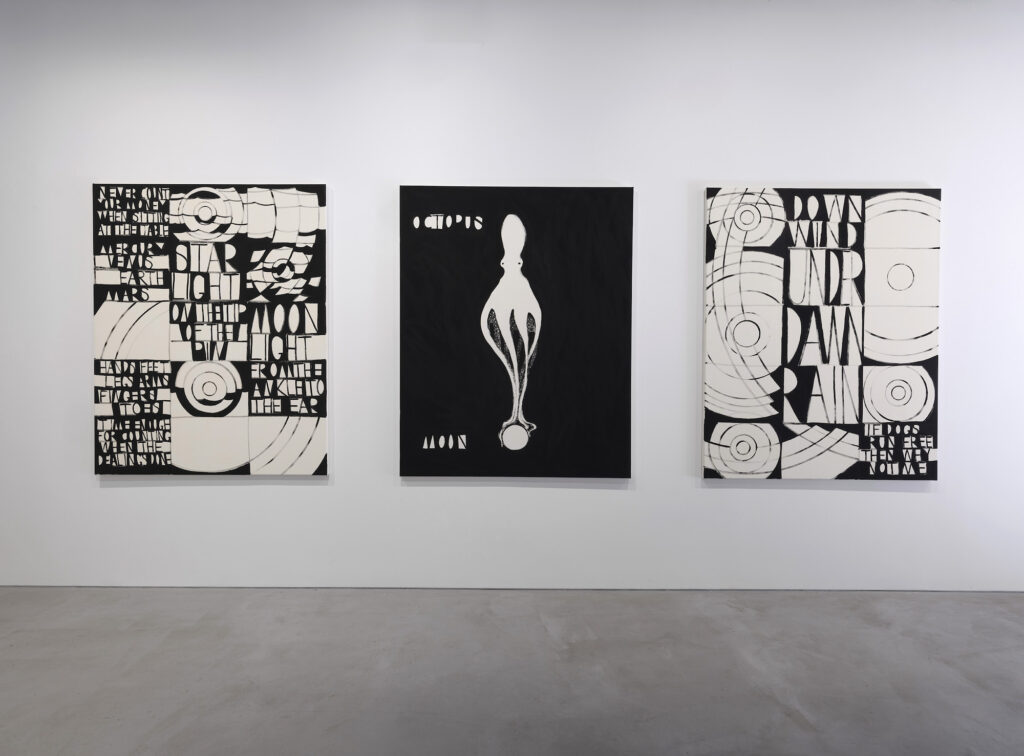
Is time running out? If Snowball’s paintings of gauges are to be considered, pointing to their bright orange extremities, the answer is an emphatic yes. While these pieces (Gauge (2024), Two Gauges (2024)) appear at first to be another surprise gear change in their content, they also fit within the broader Snowball project. Rendered in a clumsy hand, these pieces deny the delicate tones and details of the Travelling Light (2024) watercolours and instead deliver the image as a blunt instrument, eschewing even numbers or letters, relying on small, uneven notches to convey a sense of cartoonish alarm.

In contrast, the Travelling Light works embrace the abstract more completely, settling into delicate studies of form and colour. These intimate studies have become a fixture of Snowball’s recent exhibitions. They are made in a convenient small scale while on the road, allowing for artistic explorations when no studio space was available, thus becoming a kind of visual travelogue and coda for each trip. In their vivid brightness, these works, rather than the fauna paintings, are the truer negative image of Snowball’s work. They are glimmers of light in colour scattered among the dark romance of his black and white paintings.
Whether Octopus Moon becomes a turning point in the artist’s development or an oddity cannot be answered without the benefit of hindsight, but I look forward to seeing what the seeds planted turn into as more moons come and go.
Jonathan McBurnie is an artist and writer, and is the Director of Rockhampton Museum of Art. Jonathan lives and works on beautiful Darumbal country.

